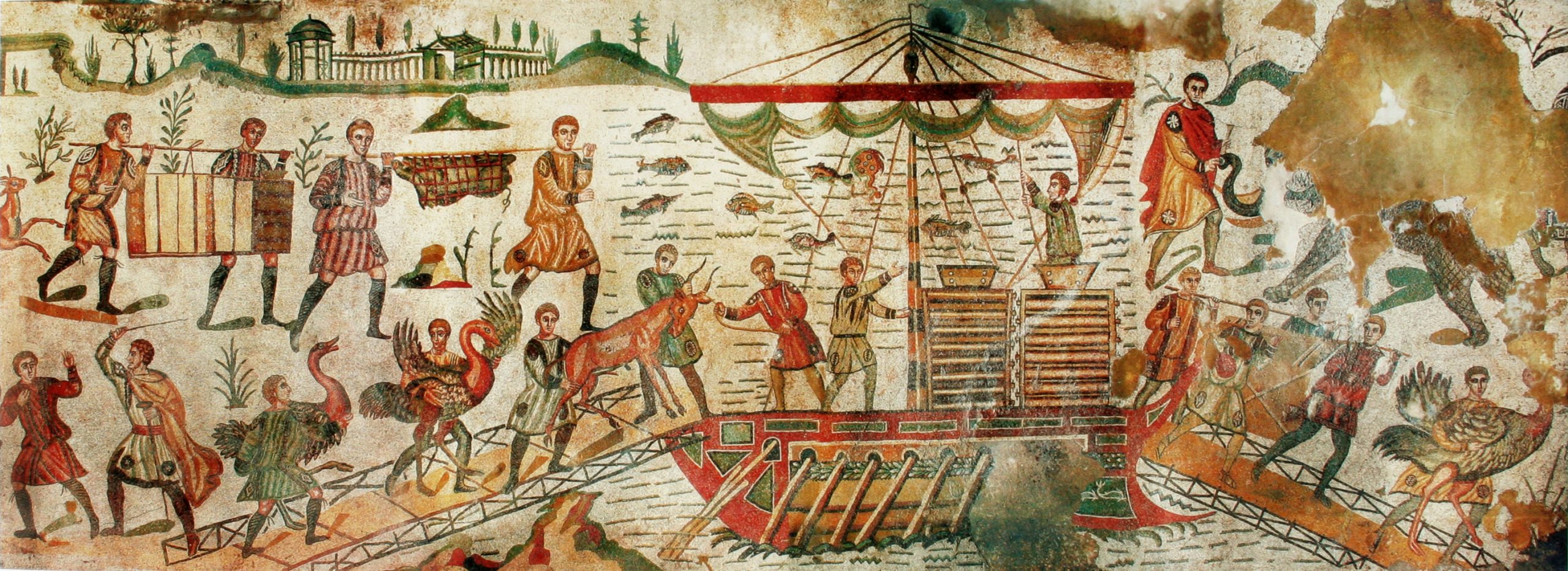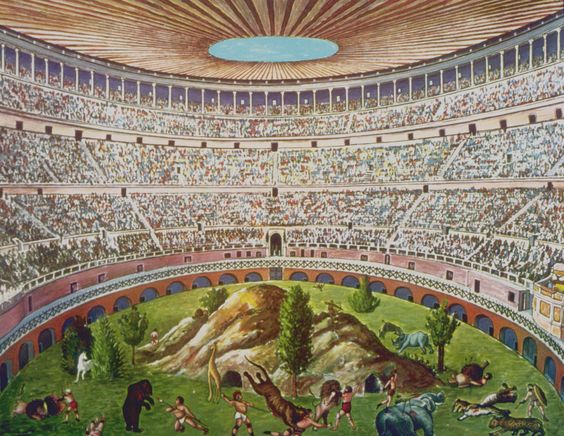
One of the spectacles at the games in the Colosseum in Rome was the Venationes or animal hunts. Flashes from movies come to mind with men in armour on a sandy arena being mauled by tigers. Was it really like that, just a display of brutality and slaughter – man vs animal? The Roman games were an integral part of Roman society and by the end of the 1st century, generals and statesmen were already displaying weird and wonderful creatures like elephants, giraffes even rhinoceros to show their power over the known world. Along with executions and gladiatorial combat the animal hunts were a part of the games that had become commonplace, although not as frequent as we may imagine! By the 4th century AD, the festival calendar had 176 days of games per year, but only 10 of those were venationes and gladiator hunts at the Colosseum. These extravagant displays were far less frequent than we imagine – it could take up to two years to arrange and transport enough animal just for 5 days of games. For those organising and paying for these animal hunts they were incredibly expensive and a logistical nightmare to arrange.
A Stage show
Forget the film Gladiator or the glitzy series Spartacus. The hunters or venator were not gladiators, there was no heavy armour or swords. The Venators were trained animal handlers without armour – graffiti from the colosseum shows us men in loincloths with spears, sometimes on horseback with bows and arrows. As with the gladiator bouts the crowd was focused on the style, bravery and skill of the hunter – much like those who watch bullfighting concentrate on the poise and concentration of the matador.

This was not just hack and slash of men versus animals, the arena of the colosseum was transformed to create a version of reality – the landscape where these creatures are found. Scenery was used, – boulders, bushes, even trees and perhaps large sets. By the second century, the colosseum had up to 60 elevators and a huge opening down the centre of the arena which allowed the shifting of great ramps bearing large structures or perhaps to release large amounts of animals at one time. This scenery or apparatus was needed to cover the trapdoors and mechanics under the arena so that it appeared to the crowd as if animals came out of caves or from trees. This was a real live hunt in realistic landscape.
What kind of animals?
Part of the appeal for the spectators was seeing weird and wonderful animals from the far-flung edges of the Empire. When victorious generals came back from foreign campaigns, they brought treasure, people (as slaves) and curiosities like exotic animals, plants and foodstuffs. In our modern age, we all know what a giraffe looks like even if we haven’t seen one in the flesh. Imagine you are a Roman, living in a bustling urban centre in the first century AD; you will have seen cats, dogs, pigeons, chickens – a rat for sure! At the venationes you might see an elephant, an ostrich or a crocodile! In the early days, animals like dogs, boar, or even an ox painted or dressed up with shiny head-dresses were used. As the Romans conquered new places, they could source animals from all over the known world. Often the more easily attainable animals were used alongside a few, choice, exotic specimens.
A beautiful fresco at Piazza Armerina in Sicily shows animals being caught and put in wagons to be shipped for the games. In this fresco we see everything from Ostriches, gazelles, panthers, leopards even a rhinoceros. Where did the Romans get these animals? Deer and dogs came from Britain, bears and wolves came from France, exotic animals like hippopotamus, rhinoceros and crocodiles came from Egypt and big cats from North Africa. By the time the games were outlawed in 523 AD, whole species of animals had disappeared from North Africa and even Scotland.
Logistical nightmare
Organising animals for the games was a logistical nightmare, they had to be sourced, caught and transported which meant keeping them alive on the long journey home. In the 60s BC Cicero complains about six panthers he had ordered for his games saying the ‘mangy cats’ that arrived, wouldn’t scare anybody. The Romans were constricted by sailing seasons, cargo ships could only travel at certain times of the year. Military style organisation was needed to obtain these beasts, the legions often provided a standard hunting force. Some special units were exempt from active duty and concentrated on obtaining animals for the games like Legion I – the bear-hunters of Cologne.
How did the Romans catch animals for the games?
Catching a wide array of animals in ancient times without tranquiliser darts was an incredibly difficult task. Across North Africa there were special associations who dealt with acquisition, this was a profitable business. One such association the Telegenii not only dealt in animals but even

trained animal hunters and hired out them out as venator (much like the travelling gladiator troupes). Some animals could be captured and bred in captivity, others had to be lured into cages with smaller animals as bait, the Piazza Armerina mosaic shows animals held in harnesses and cages. The sought-after big cats were taken from their mothers as cubs, reared and trained to be more exciting for the crowd. Once the animals had been sourced, they had to be transported and may die in transit. Once they arrived at their destination, they may not behave the way the organisers had hoped – a huge crocodile brought to Rome by Augustus simply refused to play ball. Leopards are shy, solitary animals afraid of humans so they had to be trained to kill in grizzly ways, Lions too – they do not play with their prey they just sit on them and eat – no fun for the crowd!
We have to remember when we read about spectacular games using thousands of animals these were mentioned in the sources precisely because they were so extravagant. The spotlight was placed on the organiser, who had pulled off this exotic display – in most cases the Emperor. At the inaugural games of the colosseum, the emperor Titus organised 100 days of games in which we are told 5,000 animals appeared and/or were killed in the first day. Forty years later Trajan held 123 days of games in which 11,000 animals died. The most ridiculous of all was Commodus, who appeared in the arena as a hunter – his heart’s desire was to shoot and kill a rhinoceros. Of course, he didn’t risk his life! He had a huge platform built across the arena of the colosseum so that he could run backwards and forwards picking off animals with his bow and arrow the thrill of his show must have been somewhat muted even farcical.
